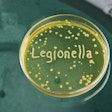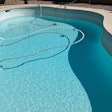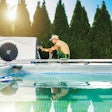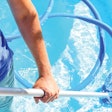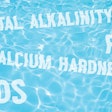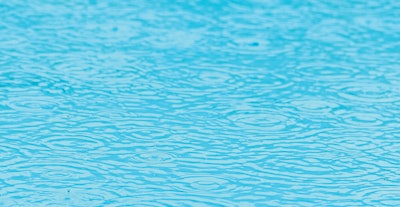
A little rain never hurt anybody...but a lot can kill your pool chemistry. Most pros have seen a storm turn perfectly clear water cloudy or green, or knock its chemical balance sideways. So, what exactly happens to the pool when it rains?
The answer, of course, is complicated — but understanding some of the basics can make aftermath maintenance easier.
COLLECTING CONTAMINANTS
Know this: Rainwater is not completely pure. “Water vapor is incapable of condensing into droplets without something for it to grab onto,” explains HASA chemistry expert Terry Arko. “This could be anything in the atmosphere at the time, including dust, smoke, industrial pollutants, nitrogen dioxide, sulfur dioxide and airborne organic material.”
Rainfall might introduce any number of these contaminants into the pool, where they’ll steal the attention of sanitizers. The more contaminants in the water, the higher the chlorine demand — and at lowered levels, chlorine isn’t as effective as it should be.
Debris closer to the ground compounds the problem. “Hard rain washes a lot of things into a pool that will eat up your sanitizer residual,” says Alicia Stephens, education and training manager at Biolab. “You’ll get ground runoff, stuff that’s coming out of the trees, leaf litter, and if you have any chemicals in your lawn, they’re draining into the pool, as well.”
SEEING GREEN
If a storm leaves the pool looking swampy, it’s because rainwater can foster the right conditions for algae growth.
“Heavy rain can dilute your sanitizer level quickly, just because you’re adding so much fresh water. When you don’t have enough sanitizer, bacteria and algae can grow,” says Stephens. “Both of those will lead to cloudy water pretty quickly once they get started.”
Not to mention that algae can feed on backyard runoff; specifically, nitrates and phosphates.
RELATED: Winterizing Inground Pools, Step by Step
“Depending on what’s getting washed into the pool, you get a lot of phosphates from the environment, so you’d expect to see the phosphate level rise after a storm,” says Stephens.
“Nitrate levels can increase considerably after a rainstorm,” adds Arko, “which could lead to an algae bloom from diluted sanitizer and an increased nutrient for the algae.”
ACID AND ALKALINE
Depending on the amount of rain that falls into the pool, storms can often mess with pH levels. And pH is the cornerstone of pool chemistry, affecting chlorine efficacy and the tendency toward corrosion or scale.
The pH of your rainwater often depends on geography. “In large cities with lots of cars, the rainwater is acidic,” says Arko, citing nitrogen and sulfur dioxide buildup in the atmosphere. “Most rain that falls in these areas has a low pH, so when it enters the pool, it can cause a reaction.
The primary effect could be a slight lowering of both the total alkalinity and pH.”
At low pH (acidic) levels, water becomes more corrosive to all metals in the pool system, from ladders, rails and light fixtures to heater elements.
But in some places, rain can also be alkaline. “That’s due to some EPA regulations that changed years ago that require factories to put scrubbers on their smokestacks, and that drives up the pH of their emissions,” explains Stephens. “So if you live close to a lot of industry or a lot of factories that are putting high pH emissions into the air, the rain picks that up, and then when rain falls, it drives the pH up.”
At high pH (alkaline) levels, water can cause calcium scale to form on plumbing, equipment and tiles.
“Another consideration of rain in relation to pH is that the disruption of the pool surface from a good downpour could actually create some aeration, which could cause the pH to rise,” adds Arko. “Probably not too drastically.”
CHECK THE FORECAST
Stephens and Arko agree that some extra pre-emptive effort will ease the damage control later. Anticipating the effects of a storm can help a pool pro quickly put pool chemistry back in range after a storm has altered it.
“Don’t just let the pool get bad and then clean it up,” Stephens advises. “If you have the right chemicals in there, it never gets bad in the first place, because it’s just cleaning everything up as it comes in.”
RELATED: Pools Are Like Dogs
“Always, always, always shock the pool before a storm if you’re able to,” she continues. “That will build your chemistry up to where it’s a little more forgiving of whatever’s going to get washed into the pool during the storm. But you don’t want to add it too early. If you see it’s supposed to storm on Tuesday, and you shock your pool on Sunday, that’s not very helpful.”
Stephens also suggests adding an enzyme and clarifier blend. “Putting that into the water before a storm will help break down any contamination that comes in,” she says.
Arko recommends buffering up both the total alkalinity and pH, by at least 10ppm and between 7.5 to 7.6, respectively. “If there hasn’t been any rain for a long time, then there’s a good chance that there is a lot of pollutant in the atmosphere, so that first rain will be loaded with it,” he says. “Top the chlorine up, and even add a polyquat algaecide to prevent a bloom from the high nitrates that could enter the pool.”
“If a very heavy and lengthy storm is expected, it may be prudent to protect the pool and the equipment from flooding with strategic placement of sandbags,” Arko adds. “Make sure all equipment and chemical storage rooms are protected from excessive moisture.”
































